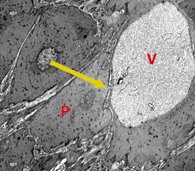Chronic vibrations constrict vessels
Many people who work with vibrating power tools develop a syndrome that starts with pain and evolves to include tingling or numbness and sensitivity to cold. Researchers at the Medical College of Wisconsin in Milwaukee think they’ve discovered a key effect of the vibrations: combined squeezing and twisting of arterial cells to the breaking point.

Sandya Govindaraju and her colleagues worked with rats, in which the tail artery is comparable to the arteries in people’s fingers. The researchers vibrated the rodents’ tails for 5 minutes to 4 hours at 60-hertz frequencies.
During each shaking, the tail artery constricted to about half its normal capacity. Also, many smooth muscle cells in the vessel’s lining began to contort and squeeze their contents into a ballooning segment known as a vacuole, explains coauthor Danny Riley. Eventually, he says, only a “gossamer” neck connected a vacuole to its parent cell.
After short periods of vibrations, the vacuole’s contents returned to the parent cell. Persistent vibrations, however, risked wrenching the vacuole from its parent, which could kill the cell. Riley, Govindaraju and their coworkers reported their findings in late April at the Experimental Biology meeting in Washington, D.C.
The good news, Govindaraju noted, is that administering a heart drug that limits vasoconstriction prevented even 4-hour vibration sessions from causing significant vessel tightening or vacuole formation.